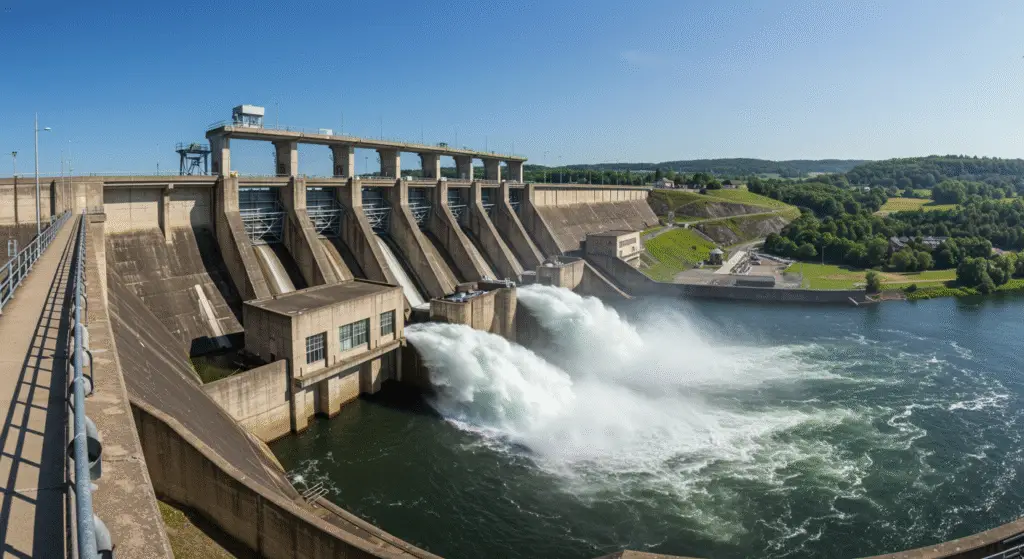What are 5 structures that are designed or constructed by civil engineers?
The field of civil engineering is responsible for shaping the very fabric of our modern societies, from the towering skyscrapers that define our urban skylines to the intricate networks of bridges, highways, and railways that connect communities across the globe. As the discipline tasked with the design, construction, and maintenance of the built environment, civil engineers wield a profound influence over the structures and systems that underpin our daily lives.
Among the myriad structures that fall under the purview of civil engineering, five stand out as particularly defining and impactful: bridges, dams, high-rise buildings, airports, and water treatment facilities. Each of these essential structures represents a unique engineering challenge, requiring the application of specialized technical knowledge, innovative design principles, and meticulous planning and execution to bring them to life.
In this comprehensive article, we will delve into the critical role that civil engineers play in the development and sustainability of these five pivotal structures, exploring their design considerations, construction techniques, and the broader societal impact they have on the communities they serve.
Bridges: Connecting Landscapes, Enabling Progress

Bridges, perhaps more than any other civil engineering structure, serve as the vital arteries that link communities, facilitate the movement of people and goods, and unlock economic and social opportunities. From the grand suspension bridges that span towering waterways to the humble pedestrian overpasses that facilitate safe passage across busy highways, these engineering marvels are the product of rigorous analysis, innovative design, and expert construction.
At the heart of bridge engineering lies the challenge of withstanding the complex forces and stresses that act upon these structures, including gravity, wind, seismic activity, and the dynamic loads imparted by vehicular and pedestrian traffic. Civil engineers must employ a deep understanding of structural mechanics, materials science, and computational analysis to model the behavior of bridges under various loading conditions, ensuring that their designs not only meet the necessary safety and performance standards but also optimize the use of materials, minimize construction costs, and enhance the overall aesthetic appeal of the finished structure.
One of the most iconic examples of bridge engineering is the Golden Gate Bridge in San Francisco, California. Completed in 1937, this 8,981-foot-long suspension bridge is a testament to the ingenuity and technical prowess of its civil engineering team. Designed to withstand the powerful winds and seismic activity that characterize the San Francisco Bay Area, the bridge’s slender, graceful towers and sweeping main cables have become an enduring symbol of the city, drawing millions of visitors each year and serving as a vital transportation link for both vehicular and pedestrian traffic.
Beyond their functional role, bridges can also serve as architectural and cultural landmarks, with civil engineers working in close collaboration with designers and urban planners to create structures that not only facilitate movement but also enhance the aesthetic and civic character of the surrounding environment. The Puente Nuevo Bridge in Ronda, Spain, for example, is a stunning example of this synergy, where a 390-foot-tall stone arch bridge spanning a dramatic gorge has become an iconic tourist destination and a beloved symbol of the region’s heritage.
As the world continues to grapple with the challenges of urbanization, climate change, and the evolving transportation needs of modern societies, the role of civil engineers in designing and constructing resilient, efficient, and visually compelling bridges will only become more critical. By drawing upon the latest advancements in materials science, computational modeling, and construction techniques, these professionals are poised to transform the way we think about and experience the bridges that connect our communities, driving progress and innovation in the field of civil engineering.
Dams: Harnessing the Power of Water for a Sustainable Future

Dams, the towering structures that impound rivers and regulate the flow of water, are among the most essential and complex civil engineering projects undertaken worldwide. These massive, multifunctional facilities serve a wide range of purposes, from generating renewable hydroelectric power and providing reliable water supplies to mitigating the risks of flooding and enabling recreational activities.
The design and construction of dams require civil engineers to grapple with a diverse array of technical and environmental challenges, drawing upon expertise in fields such as hydrology, soil mechanics, structural analysis, and environmental science. These professionals must meticulously plan and execute the construction of the dam’s foundation, walls, and associated infrastructure, ensuring that the structure can withstand the immense pressures and stresses exerted by the impounded water while also minimizing the impact on the surrounding ecosystem.
One of the most impressive examples of dam engineering is the Hoover Dam, located on the Colorado River between Nevada and Arizona. Completed in 1936, this 726-foot-tall concrete arch-gravity dam was a monumental feat of civil engineering, harnessing the power of the river to produce hydroelectric power and provide flood control and water storage for the arid western United States. The Hoover Dam’s innovative design, which features a distinctive Art Deco aesthetic, has made it a lasting symbol of American engineering prowess and a popular tourist destination.
As the world grapples with the mounting challenges of climate change, sustainable resource management, and the growing demand for clean energy, the role of civil engineers in designing and constructing dams has become increasingly critical. These professionals are tasked with developing innovative solutions that not only maximize the benefits of water-based infrastructure but also minimize the environmental impact and ensure the long-term resilience of these structures in the face of extreme weather events and changing hydrological patterns.
One such example is the Three Gorges Dam in China, the world’s largest hydroelectric power station. Completed in 2012, this colossal 607-foot-tall concrete gravity dam on the Yangtze River showcases the remarkable engineering capabilities of civil engineers, who have harnessed the power of the river to generate clean, renewable electricity for millions of people. However, the construction of the Three Gorges Dam has also sparked significant environmental and social concerns, underscoring the need for civil engineers to carefully balance the technical, economic, and ecological considerations in the design and implementation of these massive infrastructure projects.
As the global demand for sustainable water management and renewable energy continues to grow, the civil engineering profession will play a pivotal role in shaping the future of dam technology, ensuring that these essential structures can adapt to the evolving needs of communities and the natural environment they serve.
High-Rise Buildings: Pushing the Boundaries of Engineering Innovation

In the ever-expanding skylines of the world’s major cities, high-rise buildings stand as towering testaments to the ingenuity and technical prowess of civil engineers. These towering structures, which can reach heights of over 100 stories, represent some of the most complex and challenging engineering projects undertaken in the modern era, requiring the integration of specialized knowledge in structural design, materials science, and construction management.
The design and construction of high-rise buildings pose unique challenges for civil engineers, who must grapple with the effects of gravity, wind, and seismic forces on these tall, slender structures. Ensuring the structural integrity and safety of high-rise buildings requires the use of advanced computational modeling, innovative materials, and sophisticated construction techniques that can withstand the immense loads and stresses imposed on the building’s framework.
One of the most iconic examples of high-rise engineering is the Burj Khalifa in Dubai, United Arab Emirates. Completed in 2010, this 828-meter-tall skyscraper is the tallest building in the world, a feat of civil engineering that required the seamless integration of cutting-edge structural design, materials science, and construction management. The Burj Khalifa’s tapered, tripartite design, which features a reinforced concrete core surrounded by a steel frame and a glass-and-aluminum façade, not only enhances the building’s aesthetic appeal but also optimizes its structural performance, enabling it to withstand the harsh desert climate and seismic activity of the region.
Beyond their technical complexity, high-rise buildings also present civil engineers with unique challenges related to sustainability, energy efficiency, and occupant comfort. As the global emphasis on environmentally conscious design and construction continues to grow, civil engineers are tasked with developing innovative solutions that minimize the environmental impact of these towering structures, from the incorporation of renewable energy systems and advanced insulation materials to the optimization of water usage and waste management.
One such example is the Pearl River Tower in Guangzhou, China, which was designed by civil engineers to be one of the most energy-efficient skyscrapers in the world. Featuring a distinctive aerodynamic shape, wind turbines integrated into the building’s façade, and a highly efficient HVAC system, the Pearl River Tower demonstrates how civil engineers can leverage their technical expertise to create high-rise structures that not only push the boundaries of engineering innovation but also contribute to the sustainability of the built environment.
As the world’s population continues to urbanize and the demand for high-density living and working spaces increases, the role of civil engineers in designing and constructing safe, functional, and environmentally responsible high-rise buildings will only become more critical. By combining their deep understanding of structural mechanics, materials science, and sustainable design principles, these professionals are shaping the future of urban development, redefining the limits of what is possible in the realm of tall building engineering.
Airports: Gateways to a Connected World

In the age of globalization, airports have emerged as essential hubs of transportation and commerce, serving as the vital gateways that connect people, goods, and ideas across vast distances. The design, construction, and maintenance of these complex, multifaceted facilities fall squarely within the domain of civil engineering, requiring the integration of specialized knowledge in areas such as structural engineering, transportation planning, and environmental management.
Civil engineers tasked with the development of airports must address a wide range of technical and logistical challenges, from ensuring the structural integrity of the terminal buildings, runways, and taxiways to optimizing the flow of passenger and cargo traffic, managing stormwater drainage, and mitigating the environmental impact of aircraft operations. These professionals must also work closely with architects, urban planners, and regulatory agencies to ensure that the airport’s design and construction align with the unique needs and constraints of the local community.
One of the most impressive examples of airport engineering is Changi Airport in Singapore, which has been consistently ranked as one of the world’s best airports. Designed and constructed by a team of civil engineers, Changi Airport’s terminals feature innovative structural design, including large-span roofs and column-free spaces that enhance the passenger experience and improve operational efficiency. Additionally, the airport’s comprehensive stormwater management system and extensive landscape features, including lush gardens and a sprawling butterfly garden, demonstrate how civil engineers can integrate sustainable design principles into the development of these critical transportation hubs.
As the demand for air travel continues to grow, driven by increasing globalization, economic development, and the need for efficient long-distance transportation, the role of civil engineers in designing and constructing airports will become increasingly crucial. These professionals will be tasked with developing innovative solutions that can accommodate the rising number of passengers and cargo, while also ensuring the safety, security, and environmental sustainability of these vital infrastructure projects.
One such challenge is the need to accommodate the growing prevalence of unmanned aerial vehicles (UAVs), or drones, in both commercial and recreational applications. Civil engineers must work closely with aviation authorities and regulatory bodies to develop airspace management systems, ground support infrastructure, and operational protocols that can safely integrate UAVs into the existing airport ecosystem without compromising the safety and efficiency of traditional aircraft operations.
By leveraging their technical expertise, problem-solving skills, and commitment to sustainable design, civil engineers will play a pivotal role in shaping the future of airport infrastructure, ensuring that these gateways to a connected world can meet the evolving needs of both travelers and the global economy.
Water Treatment Facilities: Ensuring a Sustainable Water Future

In an increasingly water-scarce world, the design, construction, and operation of water treatment facilities have become essential responsibilities of civil engineers. These complex, multifaceted systems are responsible for the purification and distribution of clean, safe water to communities, industries, and agriculture, playing a vital role in maintaining public health, supporting economic development, and safeguarding the natural environment.
The design of water treatment facilities requires civil engineers to possess a deep understanding of hydrology, water chemistry, and environmental science, as well as the technical expertise to translate these principles into robust, efficient, and sustainable infrastructure. From the intake structures that draw raw water from surface or groundwater sources to the advanced filtration and disinfection systems that remove contaminants, civil engineers must carefully consider the unique water quality, quantity, and environmental factors that characterize each project site.
One exemplary case of water treatment engineering is the Potable Water Treatment Plant in Fukuoka, Japan, which was completed in 2015. Designed to serve a population of over 1.5 million people, this state-of-the-art facility showcases the innovative design and construction techniques employed by civil engineers to ensure the reliable and sustainable production of clean drinking water. The plant’s advanced membrane filtration technology, coupled with its energy-efficient operations and comprehensive water quality monitoring systems, have earned it recognition as one of the most advanced and environmentally responsible water treatment facilities in the world.
As the global population continues to grow and climate change exacerbates water scarcity in many regions, the importance of water treatment infrastructure will only become more critical. Civil engineers will be at the forefront of developing innovative solutions to address these challenges, from the integration of renewable energy sources and the optimization of water reuse and recycling to the implementation of advanced desalination technologies and the protection of vulnerable water sources.
One emerging trend in water treatment engineering is the increasing emphasis on decentralized, community-scale systems that can provide localized, sustainable water solutions. By designing modular, adaptable water treatment facilities that can be tailored to the specific needs and resources of individual communities, civil engineers can help to ensure equitable access to clean water while also minimizing the environmental impact and energy demands of traditional, centralized water infrastructure.
Through their technical expertise, environmental stewardship, and commitment to innovation, civil engineers play a vital role in shaping the future of water management, ensuring that this precious resource is safeguarded and equitably distributed for the benefit of present and future generations.
The Civil Engineer’s Enduring Impact
The five essential structures highlighted in this article – bridges, dams, high-rise buildings, airports, and water treatment facilities – represent only a small fraction of the diverse array of projects and systems that fall under the purview of civil engineering. Yet, each of these structures serves as a testament to the critical importance of this dynamic and multifaceted field, showcasing the profound impact that civil engineers have on the built environment and the well-being of the communities they serve.
Whether designing the complex framework of a towering skyscraper, constructing a dam to harness the power of a mighty river, or ensuring the sustainable delivery of clean water to homes and businesses, civil engineers are the unsung heroes who shape the physical world around us. Through their technical expertise, innovative problem-solving, and unwavering commitment to public safety and environmental stewardship, these professionals are not only transforming the landscapes of our cities and communities but also paving the way for a more sustainable, resilient, and prosperous future.
As the world continues to grapple with the challenges of urbanization, climate change, and the ever-evolving needs of modern societies, the role of civil engineers will only become more critical. These professionals will be tasked with developing cutting-edge solutions that can adapt to the changing demands of the built environment, from the construction of resilient infrastructure that can withstand the impacts of extreme weather events to the design of energy-efficient, environmentally responsible buildings and facilities.
By continuously expanding their knowledge, honing their technical skills, and embracing the latest advancements in materials, computational modeling, and construction techniques, civil engineers will remain at the forefront of the engineering profession, driving progress and innovation in the fields that shape the very fabric of our world. And as they do so, they will leave an indelible mark on the structures and systems that define our built environment, creating a lasting legacy that will continue to serve and inspire generations to come.
- https://worldcivilsociety.com/how-to-weigh-the-advantages-and-disadvantages-in-structural-engineering/
- https://worldcivilsociety.com/is-structural-engineering-a-good-career/
- https://worldcivilsociety.com/the-backbone-of-engineering-and-how-to-understand-the-importance-of-structures/
- https://worldcivilsociety.com/what-are-the-5-pillars-of-engineering/

What are 5 structures that are designed or constructed by civil engineers?
What are 5 structures that are designed or constructed by civil engineers?
The five essential structures highlighted – bridges, dams, high-rise buildings, airports, and water treatment facilities – represent only a small fraction of the diverse array of projects and systems that fall under the purview of civil engineering.